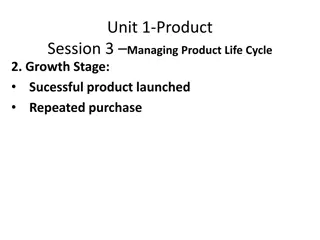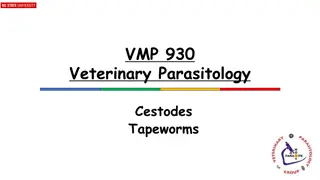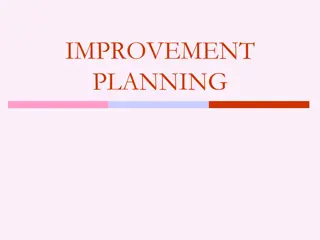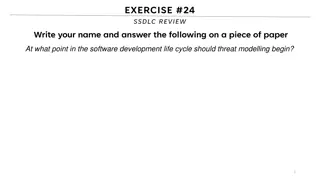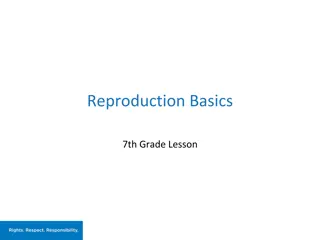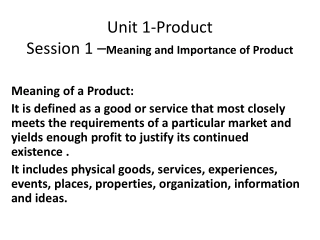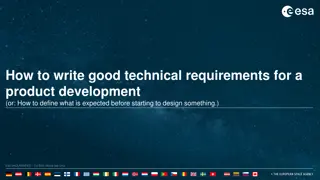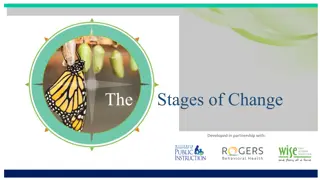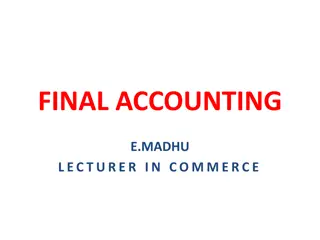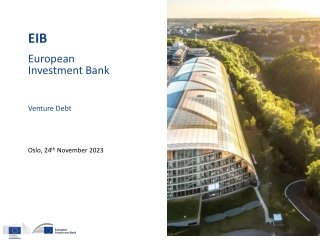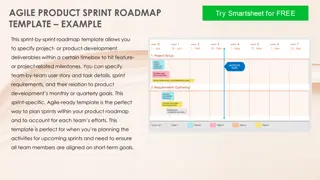Understanding the Product Life Cycle: Stages and Examples
The product life cycle (PLC) concept is essential for marketers to navigate through the stages of a product's market presence - from introduction to decline. Studying PLC with reference to demand-technology dynamics provides insights into competitive strategies. The main stages are research & development, introduction, growth, maturity, and decline, each with distinct characteristics. Examples showcase iconic brands that faced challenges due to inadequate lifecycle management. Recognizing where a product stands in its lifecycle helps in devising appropriate marketing strategies.
Download Presentation
Please find below an Image/Link to download the presentation.
The content on the website is provided AS IS for your information and personal use only. It may not be sold, licensed, or shared on other websites without obtaining consent from the author. Download presentation by click this link. If you encounter any issues during the download, it is possible that the publisher has removed the file from their server.
Presentation Transcript
PRODUCT LIFE CYCLE
Product life cycle should be studied with reference to the broad picture of demand- technology life cycle. It provides insight into the competitive dynamics. It is a ready-made or expert prescription regarding what a marketing manager should do in different stages of the PLC. However, the concept may be misleading if it is not carefully understood and followed
What are the main stages of the product life cycle? The main stages of the product life cycle are: Research & development - researching and developing a product before it is made available for sale in the market Introduction launching the product into the market Growth when sales are increasing at their fastest rate Maturity sales are near their highest, but the rate of growth is slowing down, e.g. new competitors in market or saturation Decline final stage of the cycle, when sales begin to fall This can be illustrated by looking at the sales during the time period of the product.
Typically, it passes through four stages as listed below: 1. Introduction: The product is introduced in the market. 2. Growth: The product is getting rapid acceptance and sales rise at the increasing rate. 3. Maturity (including Saturation): Sales rise, but at the decreasing rate. Saturation is marked with stable sales. 4. Decline: It is the stage when sales start falling.
Examples of Product Life Cycles Many brands that were American icons have dwindled and died. Better management of product life cycles might have saved some of them, or perhaps their time had just come. Some examples: Oldsmobile began producing cars in 1897 but the brand was killed off in 2004. Its gas-guzzling muscle-car image had lost its appeal, General Motors decided. Woolworth's had a store in just about every small town and city in America until it shuttered its stores in 1997. It was the era of Walmart and other big-box stores. Border's bookstore chain closed down in 2011. It couldn't survive the internet age.
Product life cycle is the progression of an item through the four stages of its time on the market. The four life cycle stages are: Introduction, Growth, Maturity and Decline. Every product has a life cycle and time spent at each stage differs from product to product.
The term product life cycle can be defined as under: 1. Philip Kotler: The product life cycle is an attempt to recognize distinct stages in sales history of the product. 2. PLC concerns with the study of the degree of product acceptance by the market over time. It includes major rises and falls of sales during its life. 3. Product life cycle concerns with the study of relationship between sales volume and profits in relation to time through entire span of the product s life. 4. Product life cycle is the historical study of (sales of) the product. It includes when it was introduced; when it was getting rapid acceptance; when it was on the peak of its position; when it started falling from the peak; and when it disappeared. Product passes through certain stages during its life span
S shape cure is an ideal state, and is hardly possible. Such diagram stages, sales curve, and profit curve- is possible only if following assumptions are fulfilled: 1. Product completes its entire life cycle. It passes through all four stages of its life. 2. Duration of each of the stages is equal or fixed. 3. There is no reintroduction of product. 4. Product passes through stages in chronological order, that is, one, two, three and likewise. There is no bypassing or overlapping of any of the stages.
Introduction Stage: Introduction stage starts when a new product is, for the very first time, made available for purchase. Consumers are not aware of product, or they may not have general opinion and experience regarding product. Moreover, a new product has to face the existing products. So, the sales remain limited. In the very initial stage, there is loss or negligible profit. During this period, the direct competition is almost absent. Company has not mastered production and selling problems. Price is normally high to recover/offset costs of development, production, and marketing with minimum sales. So, sales rise at gradually.
Characteristics of introduction stage include: (i) Huge selling and promotional costs are required to increase awareness of customers. (ii) Price is kept high to recover high development, production, and marketing costs. (iii) Marketer has to tackle technical and production problems. (iv) Sale is low and increasing at a lower rate. (v) There is loss or negligible profit. (vi) There is no competition
Growth Stage: This is the stage of a rapid market acceptance. Due to increased awareness, the product gets positive repose from market. This stage is marked by a rapid climb in sales. Sales rise at the increasing rate. Profits follow the sales. Seller shifts his promotional attempts from try-my-brand to buy-my-brand. Company tries to develop effective distribution network. Here, the most of production and marketing problems are mastered. Due to rise in profits, competitors are attracted. At a right time, price may be reduced to attract the price-sensitive buyers. Company continues, even increases, its selling and promotional efforts to educate and convince the market and meet competition. At the end of growth stage, sales start increasing at decelerated rate, consequently, profits starts to decline.
Characteristics of growth stage include: (i) Sales increase rapidly (or at increasing rate) as a result of consumer acceptance of the products. (ii) Company can earn maximum profits. (iii) Competitors enter the market due to attractive profits. (iv) Price is reduced to attract more consumers. (v) Distribution network is widened and improved. (vi) Necessary primary changes are made in product to remove defects. (vii) Company enters the new segments and new channels are selected.
Maturity Stage: This stage is marked with slow down of sales growth. Sales continue to rise but at decreasing rate. Competitors have entered the market and existing products face severe competition. Sales curve is pushed downward. It is just like an inverse U. During this stage, for certain period of time, sales remain stable. This level is called the Saturation. Profits also decline. Normally, this stage lasts longer and marketers face formidable challenges.
The stages may be divided into three phases: i. Growth Maturity: Sales-growth rate starts to decline. ii. Stable Maturity: Sales remain stable (i.e., saturation stage). iii. Decline Maturity: Sales now start to decline. Marginal producers are forced to drop out the products. Those who operate formulate various strategies to extend the stage. Market, products, and marketing programme are to be modified to sustain the stage
Characteristics of maturity stage include: i. Sales increase at decreasing rate. ii. Profits start to decline. iii. Marginal competitors leave the market. iv. Customer retention is given more emphasis. v. Product, market, and marketing mix modifications are undertaken
Decline Stage: This is the last stage of product life cycle. Here, sales stat declining rapidly. Profits also start erasing. There is a minimum profit or even a little loss. Advertising and selling expenses are reduced to realize some profits. This stage is faced by only those who survived in maturity stage. Most products obsolete as new products enter the market. All products have to face the stage earlier or later. New products start their own life cycle and replace old ones. A number of competitors withdraw from the market. Those who remain in the market prefer to drop smaller segments, make minor changes in products, and continue selling the products in profitable segments and channels. Here, logic has its own role. Management continues with the same product with expectation that sales improve when economy improves; marketing strategy is revised expecting that competitors will leave the market; or product is improved to attract new market segments. However, unless a strong reason exists, it is costly and risky to continue with the same products. Later on it is difficult of manage selling and promotional efforts. Marketer must check every possibility before dropping the product completely
Characteristics of decline stage include: i. Sales fall rapidly. ii. Profits fall more rapidly than sales. iii. Product modification is adopted. iv. Gradually, the company prefers to shift resources to new products. v. Most of sellers withdraw from the market. vi. Promotional expenses are reduced to realize a little profit
The advantages of forecasting the life cycle of a product to a firm are as follows: 1. When the PLC is predictable, the entrepreneur can take in advance before the decline stage, by adopting product modification, pricing strategies, distinctive style, quality change, etc. 2. The firm can prepare an effective product plan by knowing the PLC of a product. 3. The entrepreneur can find new uses of the product for the expansion of market during growth stage and for extending the maturity stage. 4. The entrepreneur can adopt latest technological changes to improve the product quality, features and design.
Important factors affecting the product life-cycle are as under:
Factor # 1. Rate of Technical Change: Rate of technical change affects the product life- cycle. If this rate is very high, the lifecycle of the products in that country will be very limited because new and improved products take place of the old products. On the other hand, if the rate of technical changes in a country is not so high, the life-cycle of the products in the country may be longer. For example, rate of technical changes in India is lower when compared with that of other developed countries. As a result of it, the lifecycle of products in our country is higher than that of the developed countries
Factor # 2. Rate of Market Acceptance: Product lifecycle is also affected by rate of market acceptance. If the rate of market acceptance is high the lifecycle of products in that country is limited. It is because the customers who have accepted the new products today can accept another product tomorrow and the existing products will soon stand out of the market. Similarly, if the customers accept the product at a slow rate, the life cycle of the products may be quite long. For example, in India, the market acceptance is very slow, and therefore, here life span of the products is very long. Factor # 3. Ease of Competitive Entry: The success or failure of a product in the market depends to a large extent upon the situation of competition in the market. If the competitors can enter into a market very easily, the lifecycle of the product will be very short because the competitors can drive the products out. On the contrary, if the competitors cannot enter into a market so easily, the lifecycle of products in such market can be fairly long.
Factor # 4. Risk Bearing Capacity: If the enterprises have risk bearing capacity, they can keep their product alive in the market for a long period as they can face the challenges of the market very effectively. Factor # 5. Economic and Managerial Forces: Economic and managerial forces of an enterprise also determine the success of the enterprise in the market to a great extent. Enterprises having strong economic and managerial forces, can keep their products standing in the market and the lifecycle of their product will be longer that of the lifecycle of the products of those enterprises having weak economic and managerial base
Factor # 6. Protection by Patent: If the patent of a product is registered, the lifecycle of the product can be fairly long, and if the patent of a product is not got registered, the lifecycle of the products gets cut-short. Factor # 7. Personnel Strategy: Product lifecycle is also affected by the personnel strategy used in marketing. Factor # 8. Business Reputation: Business reputation also affects product life cycle. If the reputation is good in the market as the producer of good quality products, its product will last long in the market as compared to the products of those enterprises whose goodwill is not good or which are not much known to the public.
a marketer should adopt the following strategies before introducing a product in the market: (i) A basic product or service should be offered. Since there are no (or few) competitors the company should enjoy early bird status. (ii) Price should be high; since cost per unit to the company is high and profits are negligible. (iii) Selective and effective distribution network should be chosen. (iv) Advertising should be done at a large scale in order to build the product s awareness among early adopters and dealers. (v) Heavy sales promotions should be done to encourage trials
following strategies should be adopted by any product manager at growth stage of a product: (i) Apart from the basic product its extensions should be introduced. (ii) Mass marketing should be done in order to penetrate deeper into the market. (iii) Create a brand image; utilize the advantage of being an innovator. (iv) Distribute the product intensively. (v) Reduce sales promotion/since the demand is already high. (vi) Build awareness and interest in the market by advertising
Maturity Stage: This is the third stage of PLC. It stays longer than other stages and poses big challenges to the marketers. The maturity stage is further divided into three phases growth, stable and decaying maturity. In the first phase, the sales growth rate starts to decline. There are no more distribution channels to tab as all the existing channels have been used. New competitive forces emerge. In the second phase, sales flatten on per capita basis because of market saturation. Most of the population has tried the product and future sales are governed by replacement demand. In the third phase of decaying maturity, the absolute level of sales starts to decline and customers begin switching to other products. The third phase of maturity poses the greatest challenge.
Strategies generally adopted at this stage by marketers are: (i) Increase in advertising, both trade and consumer promotions. (ii) Frequent markdowns. (iii) Increase in R&D budget to bring in product improvements and line extensions. (iv) Market Modification A company might try to expand the market for its mature brand by working with two factors that make up sales volume viz., Number of brand users and Usage rate per user. (v) Product Modification Managers also try to stimulate sales by modifying the product s characteristics through quality improvement, feature improvement or style improvement. (vi) Marketing program Modification A marketer can think in terms of modifying his marketing program features like price, distribution, advertising, sales promotion, personal selling and services for better acceptability of the product.
In the decline stage of PLC, a manager should adopt the following strategies: (i) If the product line is weak, then a manager should phase it out. (ii) Cut prices of the product. (iii) Reduce the sales promotion to minimal level. (iv) Reduce the advertising expenditure to the minimum level needed to retain hard-core loyals.



